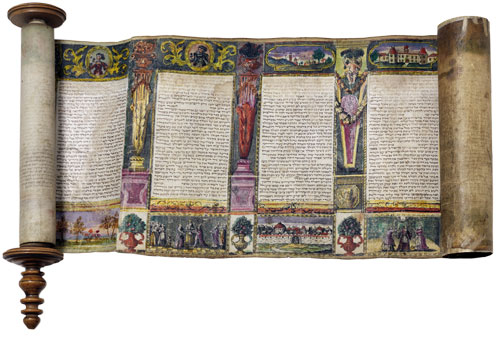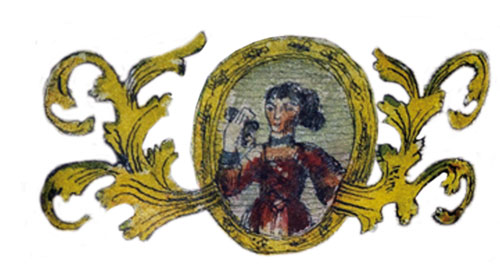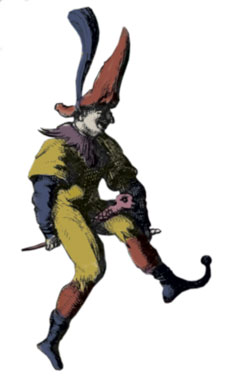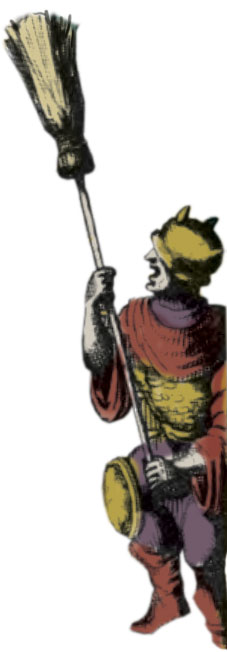Unwanted Guests
Reb Yeshaya Priwes was not enamored of the Purim players, or of their plays. He had no liking for simple people, and theater was certainly not his scene. When Purim came, however, he had no choice but to accept the coarse “players” cavorting over his wax-polished floors as a necessary evil, shattering the accustomed silence that reigned supreme throughout the year. The Purim plays and songs could not make him bat an eye, let alone betray him into the slightest show of mirth. They were just a nuisance. But he had no choice. Purim. It was their day. Nonetheless, Reb Yeshaya would have the merrymaking cut short and the money distributed together with slices of sweet challah – all without allowing his warm, manicured fingers to come into direct contact with the clumsy hands of the Purim players. (Yehiel Yeshaya Trunk, Poland: Memories and Pictures, p. 91 [Hebrew])
This was the scene described in Yehiel Yeshaya Trunk’s memoirs: poor players crowding the home of one of Warsaw’s wealthy Jews at the end of the 19th century. On Purim, the closed doors of the Priwes mansion were opened to the masses, and they poured in to perform plays such as The Sale of Joseph and Ahasuerus in the magnate’s open house. It was their privilege, on this one occasion, to shake his hand, drink a le-haim of his schnapps, and gaze in amazement at the earrings and necklaces adorning the women of the household.
The players at these performances were no professionals. They generally came from the lower echelons of Jewish society: yeshiva students, tradesmen and their apprentices, entertainers, klezmer musicians, and professional beggars. “Invading” the homes of the upper middle class, they would perform their plays, collecting money or leftovers as payment. The encounters brought two very different strata of society in contact with each other, and were at times rife with class tensions.
The earliest extant text of a complete Purim spiel (or play, in Yiddish) dates from the end of the 17th century. As this was popular theater, with a minimal script and a good deal of improvisation, this text is probably not strictly representative of the actual performance, nor is it a clear indication that purim spiels were already a well-known phenomenon. Ahuva Belkin, author of The Purim Spiel: Studies in Popular Jewish Theater, suggests that such performances had already begun to take shape two hundred years earlier, in the 15th century. Performed in Yiddish, the subjects were usually free (and often riotous) adaptations of Bible stories. The megilla itself was obviously a constant favorite, but the stories of Joseph, David and Goliath, and even the Binding of Isaac, were equally popular.
Subversive Carnival
Purim belonged to the masses, whether Yeshaya Priwes liked it or not. Communal solidarity is deeply embedded within the Purim obligations of sending food parcels to fellow Jews and distributing alms, but the Purim spiel went one step further, addressing class conflicts. The spiel drew inspiration from other carnival festivities, widespread in Christian Europe in the Middle Ages and in the early modern period, such as the Comedia della Arte, in which such characters as Fool, Doctor, Harlequin, and Pulcinella (the origin of the British Punch) wrought havoc on the established hierarchy of society. The carnival undermined the stable power of authority, and in the fantasy world created by carnival theater, it was overturned completely.
Researchers debate whether the carnivals served merely as a pressure valve, releasing class tensions, or whether they also offered truly revolutionary opportunities. Did the temporary relaxation serve only to prolong a repressive social hierarchy, or by introducing the possibility of imagining change, did it help to engender revolution? Whatever the case, the driving forces behind the Purim spiel were not content with turning the bourgeois homes of wealthy Jews into the carnival domain of the lower classes; the spiel also tended to dismantle the power structures within Jewish society, bursting the balloon of their authority.
Although the Purim spiels were mostly faithful to the general megilla narrative – Vashti’s fall and Esther’s rise, the decree against the Jews, and their victory over their enemies – the actors were not afraid to modify the biblical text. Moreover, the humor in these performances was far from refined or cultured. For contemporary readers, many of whom have a somewhat stilted image of past Jewish communities and their traditions, exposure to the Purim spiel scripts may be a rather surprising, even disturbing experience.
The Joke’s on Us
Of all the characters in the book of Esther, in the Purim spiel it is actually Mordecai the Jew who pokes fun at everything normally sacred. Unlike the wise, dignified Mordecai whose long, white beard and royal blue raiment are so familiar from illustrated megillas and children’s costumes, the Mordecai of the Purim spiel is generally a grotesque joker. In a spiel performed in the Mohilev district of Russia, for example, Mordecai was portrayed as the wandering Jew:
A poor man, a beggar, at every wedding and bris / where nothing is lacking / it’s all on the plate / what a picture – just look at him / with the hump on his back / looking down at the ground. (Belkin, The Purim Spiel, pp. 125–6)
The description of Mordecai as a beggar with a hunchback, coming to weddings just for the food, echos the stereotype of the Eastern European Jew. In the Purim spiel, however, the Jews are not only the subject of this caricature but its creators, undermining the nobility of the hero who saved his people. This Mordecai represents the players themselves – and as such he subverts the authority of the king. In a text from the early 18th century, Mordecai addresses Ahasuerus in no uncertain terms:
You are the king, but I would say / you look like a guts washer / like a rope bearer / like a pile of corpses / like a dog whipper / like a cat catcher. / But since you are the king/ hold my stick. (ibid., p. 168)
Here Mordecai serves as a jester – the familiar buffoon of European literature and drama in the early modern age – whose prime function is not to amuse the king, but to make a laughingstock of him.
But Mordecai the clown isn’t content to poke fun at Ahasuerus, who is in any case the butt of traditional interpretations of the book of Esther. Mordecai’s humor also undermines the authority of Jewish tradition. The text quoted above continues with his praying, calling on the patriarchs and matriarchs of the Jewish people to help save the nation from Haman’s decree; but his prayer is a far cry from traditional utterances of spiritual distress:
Forefathers, you sleep in the Cave of Makhpela / yet you do not react to this terrible decree! / Joshua led us to the land / but now leaves us in the wicked Haman’s hands. / And so Abraham skins animals, / Moses is blind, / Sarah washes guts. / Get up already / and cancel the great decree! (ibid., p. 132)
Not only are the forefathers of the Jewish people grotesquely downsized, but the world of halakhic obligations suffers too. In a 17th-century Purim spiel, Mordecai recounts a portentous dream in which he is expelled from his house by his shrewish wife:
I go outside. In the stable stands my red heifer, greeting me respectfully with a flick of its tail. Its left foot shakes the lulav, its right foot beats its breast in guilt, while its behind blows a shofar blast. I realized at once that “due to our many sins,” no good would come of it. (ibid., p. 130)
Haman the Prince, Mordecai the Clown
Abraham and Sarah, Moses, and the commandments themselves are recast to emphasize their ugliest side. This is well within the carnival tradition of role reversal, juxtaposing all the taboos of daily life, from scatology to intercourse, with all things sacred.
Haman, surprisingly, is often depicted as a serious, honorable figure, a veritable prince among men, in stark contrast to the grotesque personage of Mordecai. Bylines to the Purim spiel often mention that the actor portraying Haman should be tall and good-looking with a sonorous voice. This casting only enhances the comic effect – Mordecai, the naughty, scheming clown, is paired with a serious, rigid character who serves as his punching bag. The following 17th-century dialogue is a prime example of this dynamic:
Haman: Mordecai, you old fool, bow down.
Mordecai: I’m asleep.
Haman: Bow down, you old fool.
Mordecai: I’m not home.
Haman: Bow down, old fool, I tell you / … Mordecai, if you don’t bow down / I’ll give your miserable back a real beating.
Mordecai: Oy, oy. How can I bend over and bow down before you? / You have a cross on your back / … and it’s not right / that the master should bow before his servant. / You thief, don’t you remember, when you were in trouble, / you sold yourself to me for a morsel of bread / I will gladly show you the bill of sale / … if you’d like to make the effort / you can pull it out of my backside with your teeth. (ibid., pp. 141–2)
The reference to Haman selling himself as Mordecai’s servant in exchange for bread is taken from the Talmud (Megilla 15b) and shows the depth and complexity of the Purim spiel’s reliance on traditional Jewish biblical commentary. For our purposes, it is worth noting the obsessive, monotonous manner in which Haman repeats his demand, while Mordecai juggles words and excuses to rebuff and ridicule him.
In some instances, the serious, dignified Haman actually strikes a chord with the audience. The poignant lament into which he launches as he is taken to be executed is often truly poetic.
“Now, honored Prince Haman, to what may I compare myself?” Haman asks himself dramatically in Dos Purim Spiel, a text from the town of Elisavetgrad, Russia, published by the ethnographer Samuel Weissenberg. And later in the same play:
Is the beggar who goes from door to door / seeking scraps of food to assuage his hunger / a worse fate than any I could imagine? / Yet if only I might live under the bright sky…. / Now, honored Prince Haman, to what may I compare myself? /To a mosquito on a whitewashed wall, /squashed by a child with the palm of his hand. / … What’s the point of a man who lives a thousand years / with his hair turning gray / if, when his day finally comes, he has to die? (ibid., p. 177)
This almost tragic tone may have generated peals of laughter from the Jewish audience, rejoicing in the downfall of their oppressor, but at least one account of a Purim spiel describes Haman moving onlookers to tears:
His deep voice resounded over all the grand homes and their chattering geese. The servant girls shed many a tear at his melancholy songs, and as he walked to the gallows singing Haman’s lament, they cried bitterly. (ibid., p. 176)
Vashti’s Toothache
Esther and Vashti interact in not dissimilar fashion. The character of Esther – central to the Megilla – plays second fiddle to Mordecai in the Purim spiel. She appears relatively little, and is more often described by Mordecai, now a smooth-tongued matchmaker desperate to “sell” her to the king in the most grotesque and vulgar terms. The talmudic tradition (Megilla 13a) that Esther was “greenish,” ugly, or “half green, half yellow” (ibid., p. 156) is nicely developed in at least one Purim spiel. By contrast, Vashti is a beautiful young girl, her skin white as snow – a portrait consistent with the talmudic view (Megilla 15a) that Vashti was one of the four most beautiful women of all time. (Esther doesn’t even make the list.)
Since the Purim spiel players were almost always male, Vashti’s soft, feminine beauty often contrasted comically with the actor playing the role. Evidently no attempt was made to disguise the actors’ male physique when they played female roles; instead the Purim spiel exploited the resulting grotesquerie for comic effect. Sometimes the actor portraying Vashti had the beginnings of a beard, which had to be hidden by a scarf. The scarf was attributed to a sudden toothache that had struck the queen, which in turn became the reason for her refusal to appear before the king. Over the years, Vashti’s toothache became a recurrent comic motif in the Purim spiel.
Ugly Esther and grotesque Mordecai, and attractive, dignified Haman and Vashti, present an inverted picture in which beauty is no longer identified with good, nor ugliness with evil. The unsightly figures represent the forces of life, continuity, and survival, while the serious, dignified characters are associated with destruction, death and failure. The simplified, intuitive world of our imagination has been turned topsy-turvy.
Haman the Jew
Subtly underlying the Purim spiel narrative is an internalization of the anti-Semitic stereotype of the ugly, grotesque Jew, in contrast to the classically beautiful non-Jew. The depiction of Mordecai as a wandering Jew accentuates this tendency. The Purim spiel often included a scene in which Jews were handed over to the authorities, with Haman complaining vehemently of their despicable practices and character. The Jews were depicted as a nation of liars, stooping to all manner of depravity; they were referred to as “circumcised wild animals” or “wild Hebrews.” The actors in the Purim spiel took the anti-Jewish images that were common in Europe and made them their own, taking all the sting out of them, rather than trying to contradict them directly. The Jew may be ugly, but in the logic of the carnival it is the grotesque that is victorious. When the wicked Haman vilifying the Jews is himself a Jewish actor, the tables are turned, the roles have been inverted, and the Jew can portray his oppressor with no holds barred, at least once a year. The talmudic obligation to get drunk on Purim until one cannot differentiate between “Cursed be Haman” and “Blessed be Mordecai” is fully realized in the Jew playing Haman: one individual encompassing both Haman and Mordecai, blurring the boundaries between them. The Purim spiel took all the tensions pulling at the community – between rich and poor, between the authority of tradition and the demands of daily life, between Jew and non-Jew – and held them up to ridicule, spinning them around and returning them, a little disoriented, to the post-Purim reality of life.






